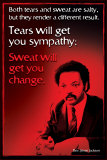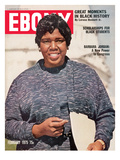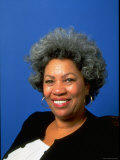|
|
Black History Posters: Outstanding Contemporary African Americans Poster Series
|
history > black history > OUTSTANDING CONTEMPORARY AFRICAN AMERICANS < social studies
|
|
The Outstanding Contemporary African Americans series of posters: Barbara Jordan, Jesse Jackson, and Toni Morrison, make great educational and teaching resources for the social studies, history and language arts classrooms and home schoolers for Black History Month, as well as motivational and inspirational images for the office.
|
|
Jesse Jackson Wall Poster
b. 10-8-1941; Greenville, SC
On the night of July 19, 1988, under the hot glare of TV lights, the Rev. Jesse Jackson stood before thousands of people gathered for the Democratic National Convention in Atlanta and delivered a speech that former president Jimmy Carter called “the best speech ever given at a convention, certainly in my lifetime.” Although the Rev. Jackson's candidacy for U.S. president had ended in disappointment only days earlier, he brought the crowd to its feet with a stirring, emotional address in which he reached out to the nation's poor and urged them to "keep hope alive!". By the time he finished, those who were not cheering were wiping away tears.
When he was born in October of 1941, few people would have guessed that Jesse Jackson would one day come closer to winning the White House than any other Aftrican American man in history. His mother, Helen Burns, was 16 years old and unmarried when Jesse was born. Two years later, she married a man named Charles Jackson, who eventually adopted Jesse. Jesse's boyhood home in Greenville, South Carolina, was a three-room cottage with no running water and an outdoor toilet.
But early on, people knew Jesse was going to be special. In school he was an honors student and a top athlete in three sports. He was offered a scholarship to attend the University of Illinois, but after his freshman year he transferred to North Carolina A & T, a largely black school in Greensboro. There, he became active in the growing civil rights movement and he met Jacqueline Lavinia Brown – the woman who became his wife.
Soon Jesse Jackson was known as a leader in the struggle for racial equality. In 1965 he joined the Southern Christian Leadership Conference. The civil rights organization created by Martin Luther King, Jr. The Rev. Jackson headed up the SCLC's efforts in Chicago and soon became an important aide to Dr. King. After King's assassination, in 1968, the Rev. Jackson continued his efforts to help blacks through organizations such as Operation Breadbasket and People United to Serve Humanity, or PUSH. In 1984, he ran for president for the first time, losing the Democratic nomination to Walter Mondale. In 1988, the battle was between the Rev. Jackson and Massachusetts governor Michael Dukakis. Even though Governor Dukakis became the nominee, Jesse Jackson won several important state contests during the campaign.
In 1990, the Rev. Jackson ran for and won the post of "shadow senator" for Washington, D.C., which made him a non-voting member of Congress representing citizens in the District of Columbia. President Bill Clinton named the Rev. Jackson a special envoy to Africa in 1997. Today, Jesse Jackson is one of the nation's most articulate voices for African Americans and their concerns. He has inspired an entire generation of young people by challenging them to achieve and urging them to always remember “I am somebody!”
• more Jesse Jackson posters
|
|
|
|
Barbara Jordan
b. 2-21-1936; Houston, TX
d. 1-17-1996
Barbara Jordan liked to tell people that when she was born she already had three strikes against her. She was born poor, black and female at a time when to ba any one of those things was to be almost totally without power in America. Yet Barbara Jordan eventually took her place among the most powerful people in the nation. Barbara Jordan strongly believed that it is not enough just to have power – you must use it to benefit others.
Barbara Jordan was born in a poor section of Houston on February 21, 1936. At that time, segregation – of whites and blacks – was still an accepted way of life in the South. Blacks could not eat in the same restaurants as whites. They had to drink from separate “Coloreds Only” water fountains. And they were expected to sit in the back of the bus, and give up their seat if a white person wanted it. But Barbara's parents didn't stress how difficult life could be for blacks in America. Instead, they constantly told their children to become educated. As Barbara's father told her: “No man can take away your brain.” In high school, Barbara joined the debate team and discovered the special gift that would serve her throughout her life: a rich, powerful speaking voice.
Barbara decided she wanted to become a lawyer. She went to Texas Southern University near her home, and then on to Boston University Law School. After graduation, she moved back to Texas, setup a law office and ran for the Texas state legislature. Twice in a row she lost to a wealthier, better-known white candidate. But Ms. Jordan didn't give up, and in 1966 she was elected to the Texas state senate – making her the first black woman ever elected to a state office in Texas. In 1972, she was elected to the U.S. congress as a member of the House of Representatives. And in 1976, she received another great honor when she became the first black woman ever chosen to give the “keynote” speech of the Democratic National Convention.
In 1978, Rep. Jordan retired from politics and accepted an offer to become a teacher at the University of Texas. She took the job because she wanted to go back to Texas and help the people who had helped her first get elected 12 years earlier. All of her life, Barbara Jordan worked to make life better for other people – especially poor black people. When she died in 1996, she was eulogized as a hero. But she only wanted to be remembered as “someone who made a difference.”
Barbara Jordan quotes ~
• “Art has the potential to unify. It can speak in many languages without a translator. Art does not discriminate - it ignores external irrelevancies and opts for quality, talent and competence.” 1993
• “Do not call for black power or green power. Call for brain power.”
• “I felt somehow for many years that George Washington and Alexander Hamilton just left me out by mistake. But through the process of amendment, interpretation, and court decision, I have finally been included in ‘We, the people.’ ”
• “My faith in the Constitution is whole, it is complete, it is total, and I am not going to sit here and be an idle spectator to the diminution, the subversion, the destruction of the Constitution.”
|
|
|
|
Toni Morrison
b. 2-18-1931; Lorain, OH
Opera singer Leontyne Price once said of her friend Toni Morrison: “She paints pictures with words. And reading or hearing those words is like listening to music.” The idea of comparing a book to a piece of music man seem stange at first. But people have always talked about Toni Morrison's unique and beautiful “voice.” By this they mean her almost magical way of making words on the printed page come alive in the reader's imagination, so that it sometimes seems as though she or her characters are speaking directly to you.
Toni Morrison was born in the small town of Lorain, Ohio, in 1931 and given the name Chloe Anthony Wofford. But for much of her life has used the shortened version of her middle name, Toni. Her grandparents migrated north from Greenville, Alabama, in the early 1900s, finally settling in Lorain, on the shores of Lake Erie. As a child, Toni was fascinated by stories. She was one of three black students in her first grade class, and the only student who could read. She remembers how her parents told her wonderfully scary stories, and how her grandmother kept a "dream book" in which she wrote down her dreams and tried to explain what they meant. As a teenager, Toni devoured great novels by writers like Leo Tolstoy and Jane Austen. Strangely enough, however, she was not thinking about becoming a writer – she wanted to be a dancer. It was only later that she realized she had her own stories to tell, and that her true destiny was to be a writer.
When she was attending Howard University, Toni met the man she would later marry, a Jamaican student named Harold Morrison. The marriage ended in 1964, leaving her with two sons to raise on her own. She took a job as a textbook editor in New York, and began work on her first novel, “The Bluest Eye.” That was followed by “Sula” – a tragic story of two black women in Ohio. But it was her third novel, “Song of Solomon,” that first brought Toni Morrison widespread auccess and acclaim. In 1988, she won the Pulitzer Prize for her novel “Beloved.” And in 1993, she became the first African American to receive literature's highest award: the Nobel Prize. Toni Morrison's books have been praised by readers and critics for their beautiful language, vivid descriptions, and unusual combination of magic, superstition and realism. Her stories tell of the ancient struggles between men and women, between blacks and whites, between hatred and love. But most of all they tell about people – people whose lives had for too long been overlooked, and whose stories had for too many years been left untold.
• more Toni Morrison posters
• more African American authors
• Banned Books and Authors
|
|
|
|
previous page | top
|
|
I have searched the web for visual, text, and manipulative curriculum support materials - teaching posters, art prints, maps, charts, calendars, books and educational toys featuring famous people, places and events - to help teachers optimize their valuable time and budget.
Browsing the subject areas at NetPosterWorks.com is a learning experience where educators can plan context rich environments while comparing prices, special discounts, framing options and shipping from educational resources.
Thank you for starting your search for inspirational, motivational, and educational posters and learning materials at NetPosterWorks.com. If you need help please contact us.
|
|
|








